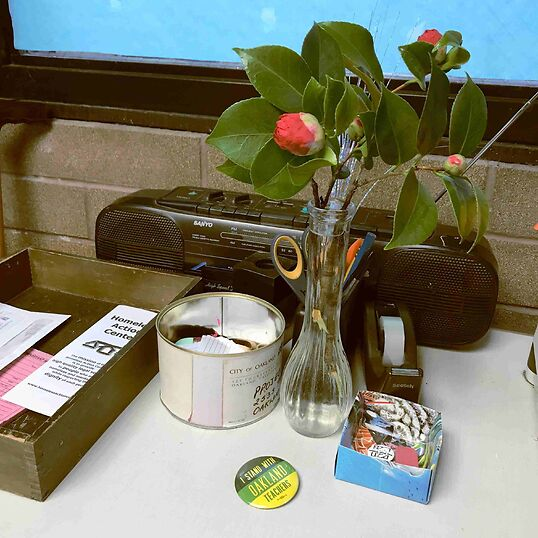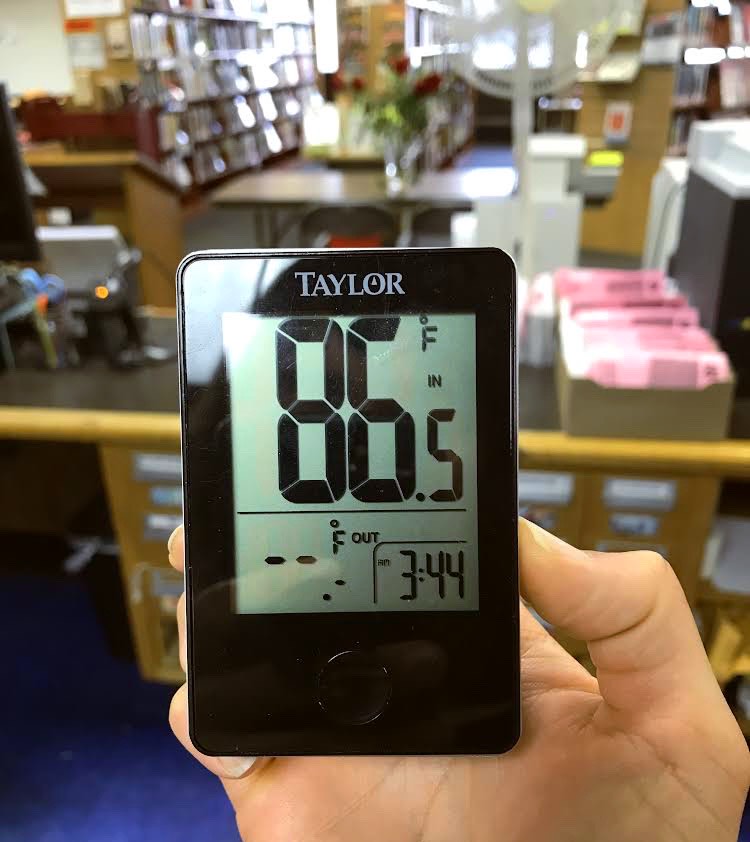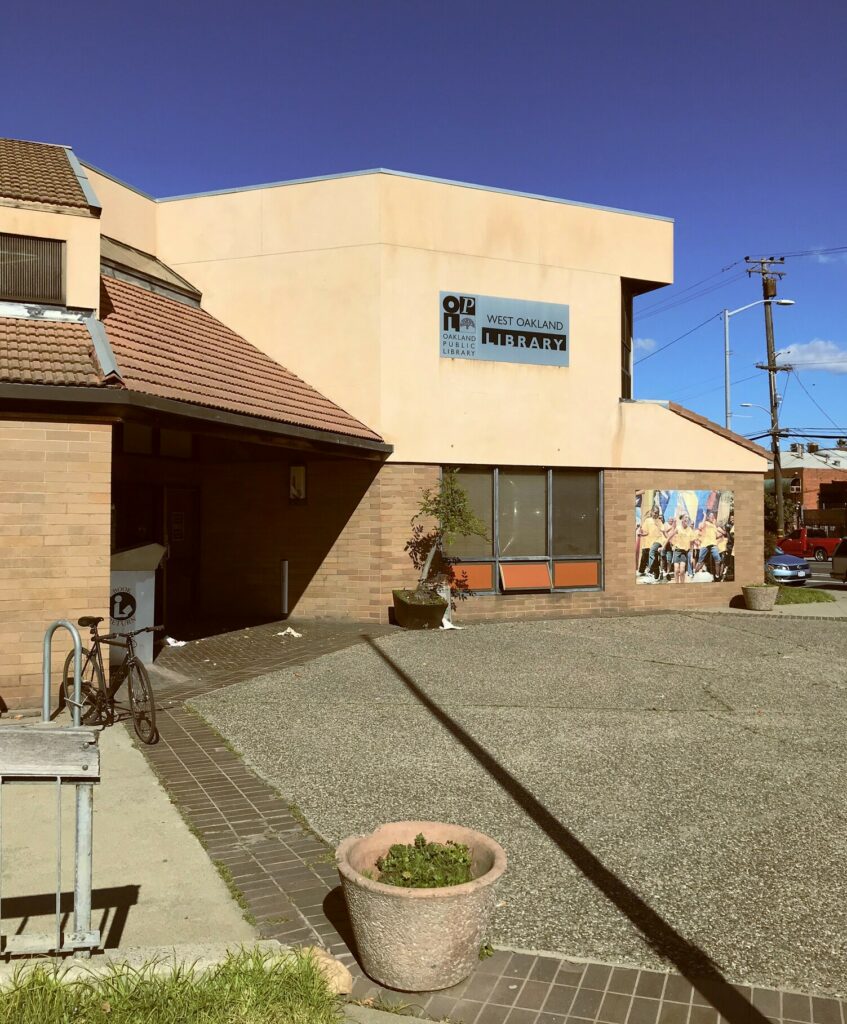
On June 10, 2019, eight of the 12 branches of the Oakland Public Library (OPL) system closed due to the heat. Ocean air and the notoriously chilly fog usually blew from the Pacific Ocean, blanketing the San Francisco peninsula and stretching a cool breeze across the Bay to Oakland. Though increasingly unremarkable at a time of countless unprecedented weather events, the area was hit with a staggering heat wave.
When we walked into the West Oakland branch that morning and prepared to open, we could already feel it in the air. As the day crept along, so did the numbers on the thermometer we kept behind the front desk. Library policy required that we close the branch if it got above 87 degrees inside. Given the temperate summers, most of the Oakland Library branches didn’t have air conditioning units.
By mid-day patrons came in expecting a reprieve from the heat, only to find it stuffier inside. We ran all the box fans we had in the building. The windows stayed closed to keep the 100 degrees outside. When the temperature crept up to the limit, the Library Director sent out a notice to close the branches by mid-afternoon.
Where were people supposed to go? Around the neighborhood, there weren’t places people could go to stay cool without having to spend money. There were only a handful of small liquor stores you could duck into that even may not have air conditioning.
As we watched that thermometer, I kept thinking to myself: why is it that in Oakland, which sits right across the Bay Bridge from San Francisco — the heart of Silicon Valley innovation, capital, and wealth — people can’t even be shielded from extreme temperatures?
The climate crisis will act to further exacerbate social inequities. Everyone will be impacted, but people with the means are going to use those means to survive. Maybe they’ll even manage to live comfortably amidst disaster. Those powerless to change their circumstances — where they live, what and when they eat, how they feel — will be forced to survive increasingly desperate conditions. It’s hard to feel this truth without the facts of it being another headline. Another shard of a grim reality amidst a barrage of grim realities.
But having to close our doors that day made it feel real, like a hot breath blowing down my neck.
All my branch needed was central air conditioning. Maybe the bureaucracy of approving budgets and construction plans is some kind of non-trivial headache. But those are organizational problems. The technology isn’t complicated. We’ve long figured out how to change the temperature of indoor spaces.
What’s missing isn’t more digital innovation. What’s missing is priority — a priority to acknowledge and address the suffering that’s felt by those marginalized and stripped of their power, by people who are already barely able to survive. As we confront the climate crisis, there needs to be a reckoning about who’s continued to benefit from, or even enable, the institutions that destroy the planet. Instead of focusing merely on dismantling this system, putting time and energy towards enabling those who are intimately familiar with their *own* communities’ challenges to enact their own solutions. Instead of seeking to be saviors, to help give agency to people who’ve been historically stripped of it. That’s only possible if individuals, and the communities they represent, have meaningful control over the levers of power.

The Joy of Public Servitude
Have you loved a job so much that you gush to your friends about it? That when you think back on it, months and years later, your heart aches because nothing felt so good, so damn fulfilling? That’s how I feel about my time working at the Oakland Public Library.
Almost all the jobs I had before and after that have felt abstract, distant from people’s real problems. They’ve involved me having to convince myself that the work was important and that it was making an impact. When I’m theorizing and organizing for the “digital commons,” I constantly questioned myself if I was making the right kind of interventions. If the things I’m fighting for — platform co-operatives, community networks, digital research and cultural archives, Free and Open Source projects — will ever become so full-fledged as to help us confront the planetary crisis that lies ahead of us.
At the library, I wasn’t fighting for a future that I wanted to manifest, I was standing in it. All the books that passed through my hands, the kindergarteners that sang along with me during story time, the patrons who gleefully placed an item in front of me to be checked out. I’d never seen so many grateful people day to day, week to week. The high you get from helping someone find exactly what they were looking for, right there on the shelf (and they don’t need to pay for it because it’s already theirs!). There’s seriously nothing else like it.
In the United States, the state of public infrastructure is bleak. Public education is bleeding quality teachers — underpaid and reasonably terrified of shootings. Our public transport is a dysfunctional joke compared to other developed nations. Our most well-resourced public institution is largely constituted of apprehensive people trained to see anyone they approach as a potential threat, armed to the teeth to give them the option of murdering at will.
But the library? In this country, they’re oases in a desert of social infrastructure. In many regions they’re more than functional, people rely on them. It’s part of their routine. It’s a safe haven for anyone, literally anyone, to use.
Due to a predominant culture of glorifying individualism, private property, and personal liberty, people here decry being a cog in a machine. But being a part of a greater public collective is seriously underrated. It’s great to know what you have to do every day and not have to question the overall purpose: to help people find the information and resources that they need. It made it easy for me to care for everyone who walked through the door or called the landline. Giving people the tools to live their lives easier and better and having my skills and labor appreciated (and fairly compensated thanks to the union) is a kind of unadulterated joy I want everyone to experience.
There’s a quote by Cornel West: “Justice is what love looks like in public.” To riff on that, I think social infrastructure is what love looks like in public. It listens and responds to the needs of people. It’s a fabric that weaves people together towards a shared community thriving. If we’re to survive the worst of what’s to come, we need to build and embolden public systems of care.
But it’s not enough for such institutions to aim for goals or merely have the right intention. The institution itself needs to look after its own, to be its own microcosm of care that it radiates outward.

A Network of Organizational Safeguards
Like most public libraries, OPL is funded out of the city budget. Oakland residents can keep their city accountable through the election of its city council member and mayor, and ensure that their beloved institution is well-funded. Additionally, Oakland holds city ballot measures to fund specific municipal programs. In 2018, residents resoundingly approved a measure to add a $75 annual parcel tax for 20 years to sustain and expand library services and operating hours. And just this summer, in June 2022, over 82% of voters showed up to renew another annual parcel tax for the next 30 years.
Then there’s the public sector union, SEIU Local 1021. Again in 2018, Oakland city workers fought and succeeded to win a two-year contract with cost of living adjustments and updated safety standards. As an organization within the institution, the union provides a direct organizational safeguard for all the library staff, to advocate for their needs and make demands of the city government.
All these gains didn’t happen overnight. They came from years of organizing, of providing services that Oakland residents came to trust and depend on. The library staff and admin built up an institution that reflects the needs and desires of its communities. The union who fights for its staff to be cared for, so they in turn can care for everyone else. And the residents, who recognize that this institution has become a backbone of their city, and that it must be funded and protected at all costs.
In many ways, the library’s governance embodies the principles laid out by Elinor Ostrom, the late Nobel–prize winning economist who studied the commons (or what she called common pool resources). She described eight principles for managing a commons, which was based on years of fieldwork and observation of stewards who successfully governed over a shared resource, such as grazing land and forests. The library ensures “that those affected by the rules can participate in modifying the rules” (principle #3) and in turn, that the rules governing the common goods match “local needs and conditions” (principle #2). And finally, the relationship between the library administration, the union, the city governance, and the community, builds “responsibility for governing the common resource in nested tiers from the lowest level up to the entire interconnected system (principle #8).
It seems to me that Ostrom did more than examine and highlight practices of successful commoning. What she did was outline protocols that enable stewards and other beneficiaries to live harmoniously in general. It’s not just the resources that people build, cultivate, and use together, the principles are an immensely helpful blueprint for how we should relate to each other. As we continue to navigate a world of more frequent ecological crises, and in turn, the desperation that will come from greater resource scarcity, these principles should act as guideposts. To build the kinds of infrastructure we need to endure together, such clear norms around governance is going to make all the difference.

Digital Commons, Libraries, and Survival
The lack of air conditioning at the library branches is dire. As the summer months get hotter, year after year, the library will need to be there for their communities to shield people from the worst of it. Despite the political power they do have, the Oakland Public Library still does not receive the funding it needs to properly protect and serve its patrons. The West Oakland branch, where I worked, currently isn’t in the works to get air conditioning.
But the patrons, staff, city council members, and unions are regularly expressing their concerns. Library Administration is fighting to turn the branches into “resiliency hubs” that are properly equipped to protect the community from extreme weather events – not only from the coldest and hottest days, but as is increasingly common in California, air quality issues from unrelenting fires. Even while they haven’t won yet, I know that they will. They’ve got the organizational will and strength – from their unions, from their patrons, and all the nested tiers of responsibility that care for this local institution.
So when I think about the types of digital spaces I want to occupy, and the tools that I want to support to enable those experiences, I look to the library as my north star. The staff were cared for, and that enabled them to exude tenderness through their work. I’ve participated in or have been in close proximity to projects that aim to build digital commons. Often, they were so myopically focused on the technology itself that they failed to fully address their own organizational health. How the participants of the project related to each other, and whether they were compensated or otherwise recognized for their contributors, were an afterthought.
I believe that in order have our networks of communication and information meet people’s needs, those building the systems not only need to be properly taken care of, but they also need to feel aligned with their contributions.
As the climate crisis worsens, we need to be able to address the failures of the massively complex systems that hold our societies together. That begins with an ability to meaningfully communicate and share information. Like societal nervous systems, digital networks should be a means to sense and identify pains, so we can begin to respond to and address the harms taking place. It should also be a source of pleasure, to identify where things are going right and embolden the beautiful, interesting, essential things and do what we can to embolden them.
I only worked at the library for one and a half years as a half-time library assistant, but it changed me. It gave me a taste of a generous future. Where, from top to bottom, people got their needs met and were fully seen for their humanity. Now that I know it can exist, I crave it. I crave it for all the digital spaces and systems I have come to rely on. It’s impossible for me to imagine and demand anything less.
